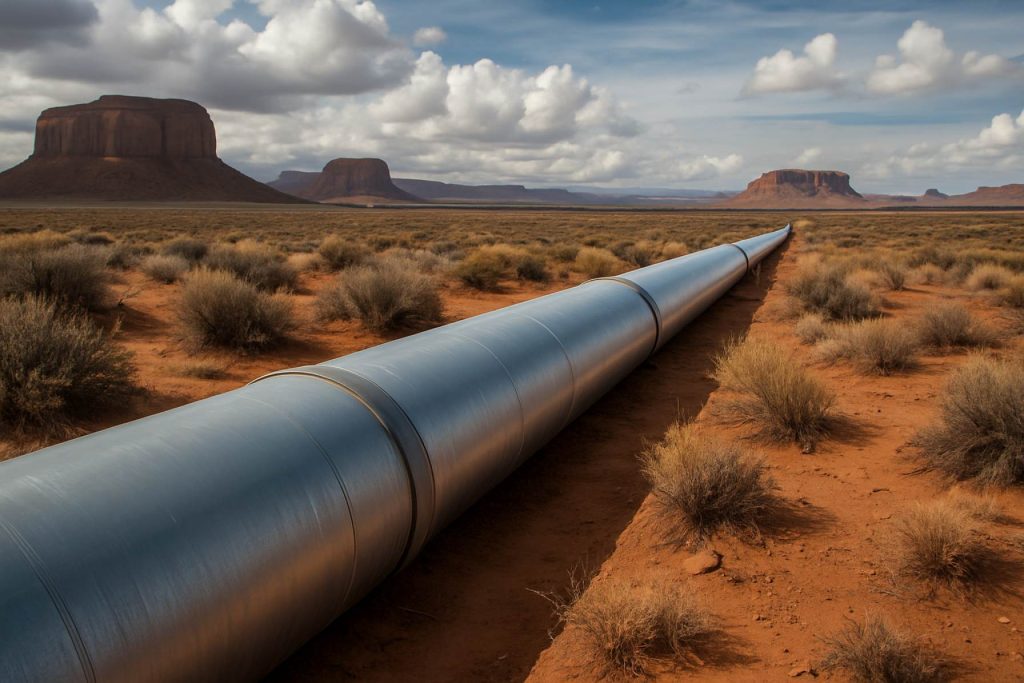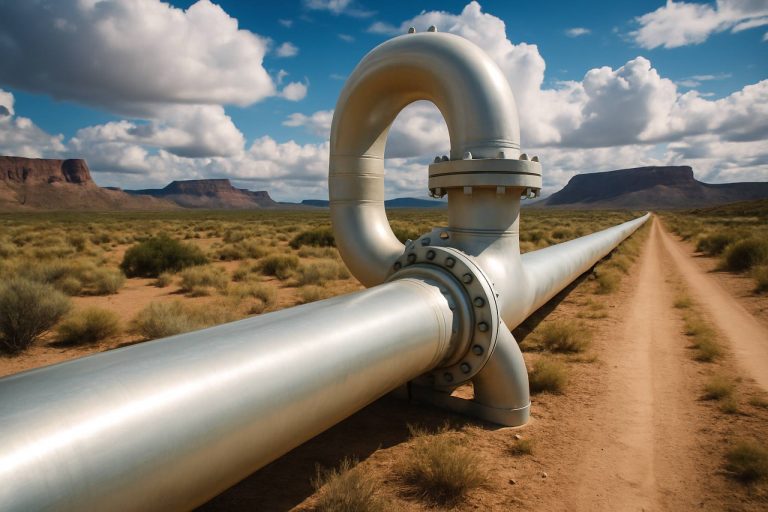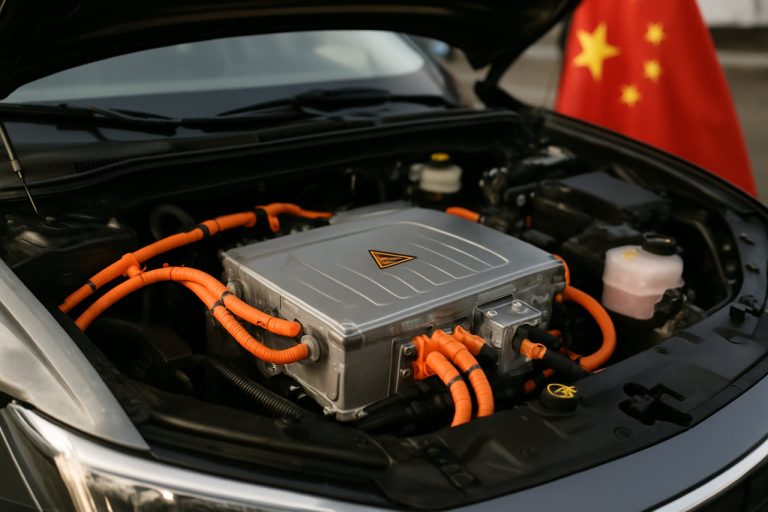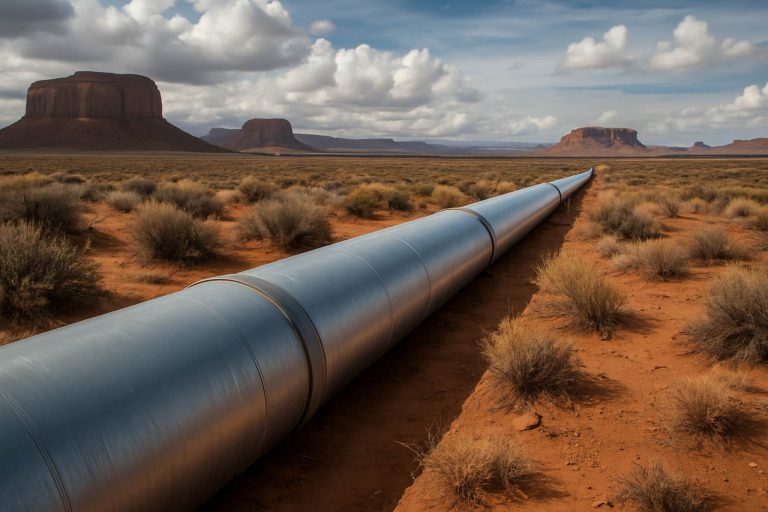
- The proposed Southwest pipeline, initially planned for “climate-friendly” hydrogen, will now transport natural gas, underscoring complexities in the clean energy transition.
- Hydrogen’s green promise is challenged by current production methods, which primarily use natural gas and emit large amounts of carbon dioxide without effective carbon capture.
- Pipelines designed for hydrogen are technologically challenging, adding risk and cost to large-scale rollouts.
- The shift to natural gas disappoints local communities, including the Navajo Nation, who hoped for cleaner energy and economic revitalization.
- Natural gas, although cleaner than coal, still poses climate risks due to methane leakage and delays investment in renewable energy like solar and wind.
- Every new fossil fuel pipeline risks locking communities into decades of carbon-heavy infrastructure, making clean energy goals harder to achieve.
Against the sun-bleached mesas and wind-carved canyons of the American Southwest, a quietly unfolding drama is reshaping the promise of clean energy—and the stakes could not be higher. A pipeline once hailed as a vessel for “climate-friendly” hydrogen, threading its way across New Mexico and the vast expanse of the Navajo Nation into Arizona, will now carry a decidedly old-world fuel: natural gas.
This pivot, subtle in its announcement but seismic in consequence, underscores the wrenching complexities of America’s energy transition.
Sparks of Hope
Farmington, New Mexico—long battered by the ebb of coal and oil—found itself at the center of a bold vision. Tallgrass Energy Partners, riding the global wave of hydrogen hype, envisioned a “hydrogen hub” that would resurrect mothballed power plants and inject new revenues into communities trailing from a century of fossil fuel extraction. Local leaders, coping with lost jobs and decades of broken promises, watched the project with a mix of excitement and skepticism.
For many corners of the energy world, hydrogen is the Great Green Hope. It can power everything from steel mills to trucks and, when burned, emits only water vapor—no climate-warming carbon dioxide. But that story is more complicated beneath the surface.
The Chemistry Turns Sour
In practice, almost all hydrogen is made from natural gas—and this “blue” hydrogen process unlocks more greenhouse gases unless carbon emissions are captured and locked away deep underground. The numbers are sobering: Manufacturing just one kilogram of hydrogen through the prevailing method creates more than eight kilograms of carbon dioxide, not including the energy required to bury that CO₂. Carbon capture, in theory, could save the day. In reality, major projects have been riddled with cost overruns, technical failures, and, more often than not, environmental disappointment.
Meanwhile, the pipelines themselves present a technological quandary. Hydrogen, uncooperative by nature, weaves through steel and can rupture infrastructure built for sturdier natural gas, making large-scale hydrogen transmission risky and complex.
Shift in the Shadows
When Tallgrass quietly rebranded the pipeline as one for natural gas—not hydrogen—officials in affected communities, including tribal leaders, were left without answers. The shift blindsided stakeholders accustomed to a sales pitch focused on green energy and economic uplift.
The pipeline’s new purpose further muddies the debate. Natural gas may emit less carbon than coal, but its extraction and transport are leaky processes—methane escaping at every step. And methane, molecule for molecule, is far more potent in trapping heat in the atmosphere than carbon dioxide. Add blended fuels—where natural gas and a small amount of hydrogen mix—and the climate benefits evaporate further.
Economic Realities, Political Tangles
For the Navajo Nation—a land rich in resources but too often denied their dividends—the pipeline’s pivot carries bitter irony. Oil, coal, and gas have enriched faraway companies, while many residents still lack basic infrastructure. Some lawmakers continue to back the project, advocating natural gas as a “bridge fuel” despite mounting evidence from organizations such as the United Nations and Rocky Mountain Institute that renewable energy—solar, wind, and battery storage—is now cheaper and cleaner for most uses. In fact, New Mexico consistently ranks among the nation’s leaders for new solar installations, and electrification projects are bringing light to more Navajo households every year.
Data, Demand, and the Future
A further twist: Arizona’s power grid is bracing for skyrocketing demand, much of it driven by energy-hungry data centers. Policymakers, seeing few short-term alternatives, have become increasingly receptive to new natural gas infrastructure.
Yet, advocates of sustainable energy warn that every dollar spent on new fossil fuel pipelines undermines investment in wind and solar. Once built, these pipelines lock in carbon-heavy energy systems for decades—making climate targets harder, if not impossible, to reach.
The Takeaway
The pipeline saga stretching between New Mexico and Arizona offers a cautionary tale: the road to a clean-energy future is paved not just with innovation, but also with difficult trade-offs, hard science, and honest conversations with the communities most affected. With the stakes so high—social, economic, and climatic—scrutiny of how “green” solutions are delivered matters more than ever.
The next transformative energy project in the Southwest might yet live up to its promises; but as this story shows, progress rarely flows in a straight line.
This Pipeline Was Supposed to Deliver the Future—Now It’s Bringing Natural Gas: What This Means for the Southwest’s Clean Energy Hopes
The Southwest’s Energy Pivot: What You Need to Know Now
America’s clean energy future just hit a critical fork in the road. A high-profile pipeline project in New Mexico and Arizona—once billed as a beacon of hydrogen-powered hope—has quietly shifted gears to carry natural gas instead. This change raises urgent questions about the nation’s climate strategy, the promises and pitfalls of emerging technologies, and the real impact on communities like the Navajo Nation.
Let’s go deeper than the headlines. Here are key facts, industry insights, real-world use cases, and actionable recommendations so you can understand what’s at stake—and what comes next.
—
Deeper Facts Not Fully Explored
1. Hydrogen’s Infrastructure Hurdle
– Hydrogen embrittlement isn’t just theoretical—it’s a major real-world challenge. Hydrogen molecules are so small they can slip through cracks in steel pipelines, causing brittleness and making leaks or catastrophic failures more likely (IEA).
– Retrofitting existing natural gas pipelines to move hydrogen can cost billions and still pose safety risks. For large-scale adoption, new materials (like advanced composites) and stringent safety protocols would be essential.
2. Real-World Use Cases of Hydrogen (and Why They Stalled)
– Only about 4% of global hydrogen production is “green” (made from renewable electricity via electrolysis). The rest is overwhelmingly “gray” or “blue”—from fossil fuels (International Energy Agency).
– Pioneering projects in Europe and Asia (like Germany’s H2 pipeline initiatives) have succeeded at small scale, but technical and economic barriers remain for mass deployment.
3. Methane Leakage: The Hidden Climate Threat
– Methane is up to 86 times more potent than CO₂ over a 20-year period (IPCC).
– Studies (Stanford, Nature) show methane leakage rates from US oil and gas systems can be 60% higher than official estimates.
– Even small leaks erode most of the alleged ‘bridge fuel’ benefits of switching from coal to natural gas.
4. Market Forecasts & Industry Trends
– The global hydrogen market is projected to reach $300 billion by 2030, with much of the growth contingent on regulatory support and infrastructure investment (BloombergNEF).
– Meanwhile, utility-scale solar and battery projects are scaling faster and at lower cost than anticipated—even in deserts and remote tribal lands.
5. Energy Demand: Data Centers Are the New Giants
– Data centers can consume as much electricity as small cities. Arizona and western states anticipate a 20-40% jump in demand over the next decade, driven largely by tech expansion (U.S. Energy Information Administration).
– Utilities embrace gas as a “quick fix,” but delay ramp-up of renewables and grid batteries.
6. Tribal Equity and Economic Justice
– The Navajo Nation has seen repeated cycles of resource extraction with minimal local benefit—up to 30% of Navajo households still lack running water or electricity.
– Renewable installations (like rooftop solar projects) in the region directly benefit residents, with programs showing significant improvement in quality of life.
7. Renewable Energy Wins—But Faces Political Hurdles
– New Mexico generated more than 32% of its electricity from wind and solar in 2023. The state is a top-five solar market and leading on renewables job growth.
– Despite dramatic cost drops, fossil fuel lobbying and regulatory inertia slow wind/solar buildouts.
—
Common Reader Questions—Answered
Is hydrogen really a clean fuel?
It depends. Green hydrogen made with renewable electricity is nearly emissions-free, but over 95% of today’s hydrogen comes from natural gas, which actually increases greenhouse emissions unless paired with successful carbon capture (which so far, hasn’t scaled reliably).
Are hydrogen pipelines safe or practical?
Hydrogen presents unique safety challenges, requiring extensive engineering upgrades before mass transport is feasible. Pipelines originally built for natural gas are risky to repurpose without major investments.
Why does pipeline change matter for the Navajo Nation?
Past resource extraction left the area with pollution and poverty, giving outside companies most of the profits. Pipelines locking in new fossil investments risk repeating these patterns, even as renewables offer more sustainable, equitable gains for local communities.
—
Pros & Cons Overview
| Pros | Cons |
|——————————————–|——————————————–|
| Natural gas emits less CO₂ than coal | Methane leaks cancel out many benefits |
| Hydrogen (if green) can be nearly clean | Most hydrogen remains fossil-based |
| New pipelines could create jobs | Fossil infrastructure locks in emissions |
| Reliable power for growing data demand | Can delay clean energy transition |
| Tribal revenues possible (if shared) | Risk of continuing economic injustice |
—
Tutorials & Life Hacks: How Can Local Residents, Consumers, or Advocates Take Action?
1. Support Community Solar: Look for co-op, rooftop, or shared solar options—often with discounts or incentives.
2. Demand Transparency: Ask local officials for clear reporting on pipeline projects, including jobs, environmental risks, and benefit sharing.
3. Advocate for Local Training: Push for workforce programs that teach solar/battery installation and maintenance, not just fossil fuel jobs.
4. Track Carbon Intensity: Use tools like the EIA’s energy dashboard to compare how much clean energy your utility is using.
5. Stay Informed: Follow trusted organizations for updates, like the Department of Energy, United Nations, and Rocky Mountain Institute.
—
Insights, Predictions & Controversies
– Building new gas pipelines is likely to face increased legal and public opposition. Expect lawsuits, protests, and regulatory delays, especially in indigenous and frontline communities.
– As Tesla, Google, and other tech giants increase their data center footprints, they’ll face corporate pressure to green their supply chains—possibly triggering faster adoption of renewables and eventually hydrogen (if “green”).
– Hydrogen could still be a game-changer for sectors that are hard to electrify (heavy industry, shipping)—but without green production and infrastructure, it’s not the climate savior it claims to be.
—
Quick Real-World Recommendations
– Policymakers: Prioritize investment in grid-scale renewables and storage over new fossil infrastructure; require methane mitigation for all gas projects.
– Communities: Negotiate for direct equity participation and local hiring if forced to accept energy infrastructure.
– Businesses: Push suppliers/utilities to increase clean energy purchases and support innovative technologies (e.g., solar+storage microgrids).
—
The Bottom Line
The hydrogen-to-gas pipeline pivot in the Southwest is a cautionary tale—reminding us that the path to clean energy is fraught with trade-offs and that accountability, transparency, and community voice matter more than ever. As renewable energy becomes cheaper and more accessible, prioritizing investments that benefit both climate and people is key to avoiding another century of broken promises.
Learn more about renewable energy, hydrogen, and how policy choices shape our energy future at trusted sources like energy.gov and rmi.org.
—
Act Today: Join a clean energy info session, check your home’s energy mix, or advocate for a fair share of new project benefits—because the next chapter in America’s energy transition is being written right now.



